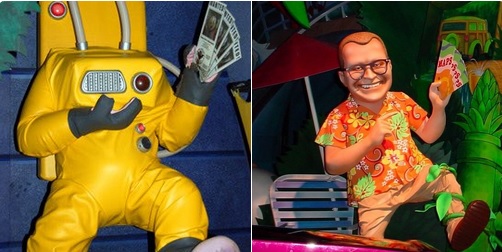Bigfoot. Mothman. The Loch Ness Monster. Even if you’ve never heard of the word “cryptozoology” or “cryptid” before, you definitely know at least one or two. One of the famous forms of pseudoscience, cryptids are the monsters and creatures that often originate from local folklore and spark the imagination of people all over the world through their constant appearances in pop culture – like theme parks and attractions!
Expedition: Everest opened in 2006 at Disney’s Animal Kingdom theme park in Orlando, Florida. It was a fantastic achievement of engineering and expenses – costing over $100 million, the roller-coaster held the Guinness World Record for “Most Expensive Roller-Coaster” (Acuna 2018). The attraction runs through the “Forbidden Mountain” hidden in the Himalayan Mountains, where the Yeti lurks, attempting to catch the guests at every turn. After a series of dips, turns, and drops, the attraction reaches a climax with the giant Yeti, one of the largest animatronics in Walt Disney World, attempting to grab at the train before the ride comes to an end.
It’s not surprising that the Yeti was chosen to be the terrifying mascot of the attraction – despite the mythical creature’s origins as part of Nepalese folklore (sometimes also referred to as “Meh-teh” or “Dzu-teh” among other names), the Yeti has since become a part of mainstream pop culture. There have been numerous expeditions since the 1930’s into the Himalayan Mountains specifically to locate the Yeti. Even the locals capitalise on the legend, with various tourist shops selling “real” Yeti fur, replica Yeti footprint casts, and “actual” photographs proving the Yeti’s existence (Loxton and Prothero 2013).

The Imagineers at Disney have always been known for creating engaging and lore-filled queues for their most popular rides and attractions. For Expedition: Everest, they chose to use a portion of the long queueing area to house a museum dedicated to the legendary creature at the heart of this roller-coaster. Various paraphernalia related to the Yeti as both a mythical creature from Nepalese tales to an actual cryptid roaming the mountains are on display – from the remains of the legendary beast’s rampage through camps to even a replica of the infamous photograph of a “Yeti footprint” by Eric Shipton from 1951 (Sim 2014). It is an extremely well done and elaborately detailed museum, using real skeletal casts of similar, real life creatures (primates, bears, etc.) and replica Tibetan artefacts to convey the history of the legend.

Perhaps unsurprisingly, this isn’t the only cryptozoological museum in the United States. From the famous Ripley’s Believe It or Not! franchise of “odditoriums” to more local museums like Expedition: Bigfoot! The Sasquatch Museum located in Cherry Log, Georgia, there are numerous examples of roadside attractions that continue the tradition of investigating
In fact, the tradition of creating “real” cryptids actually has a rather long history. Fascination with mythical creatures is perhaps old as time itself, but the idea of finding and collecting physical evidence of these creatures can be more associated with the creation of “curiosity cabinets” and various natural history exhibitions. These were, in turn, inspired by the exploration of what Europeans considered to be “undiscovered” and “uncharted” by well-funded academics and scientists (Leone 2016). Prior to blurry videos and photographs, most cryptozoological hoaxes were created through creative taxidermy – by combining the remains of different animals, you could easily falsify proof of cryptids in the same manner that natural history museums presented specimens (Jobling 2013).

Even today, many roadside attractions still continue the tradition of including cryptids alongside their real taxidermy collections – some of the most popular cryptids include the “fur bearing trout” (so cold that the trout has to grow fur to stay warm!) and the infamous “Jackalope”, which usually is a combination of rabbit remains with antlers (Krejci 2015). Perhaps by far the most famous taxidermy cryptid is the “Fiji Mermaid” – originally introduced to the American public by P.T. Barnum in the 1840’s, this cryptid is usually created by combining the upper half of a monkey with the lower half of a fish through taxidermy (Krejci 2013). Even with most people recognising the illegitimacy of these creatures, cryptids are still incredibly popular, with many loyal fans out there visiting their favourites across the country and even starting their own private collections.
Hmm…maybe I should make a point to include in my Will that I’d like my skeleton to be combined with another animal’s (a whale, perhaps?!) so I can become my very own taxidermy cryptid…
References
Acuna, K. (2018) Expedition Everest is Disney World’s Most Underrated Roller Coaster – But Its the One You Absolutely Need to Ride. Insider. Retrieved from www.thisisinsider.com/expedition-everest-review-disney-worlds-best-roller-coaster-2018-7
Jobling, M.A. (2013) The Truth is Out There. Investigative Genetics 4(24).
Krejci, J. (2013) Straight Outta Fiji: The Merman. The Carpetbagger. Retrieved from http://www.thecarpetbagger.org/2013/01/straight-out-of-fiji-merman.html
Krejci, J. (2015) North Carolina Taxidermy Hall of Fame, Creation, and Antique Tool Museum. The Carpetbagger. Retrieved from http://www.thecarpetbagger.org/2015/02/north-carolina-taxidermy-hall-of-fame.html
Leone, M. (2016) Travel, Monsters, and Taxidermy: the Semiotic Patterns of Gullibility. Religacion. 1. pp. 9-26.
Loxton, D. and Prothero, D.R. (2013) Abominable Science: Origins of the Yeti, Nessie, and Other Famous Cryptids. Columbia University Press.
Sim, N. (2014) 17 Hidden Secrets on Expedition Everest at Disney’s Animal Kingdom. Theme Park Tourist. Retrieved from https://www.themeparktourist.com/features/20140319/16970/17-hidden-secrets-expedition-everest-disneys-animal-kingdom?page=1
If you’re financially stable enough, why not donate to help out marginalised archaeologists in need via the Black Trowel Collective Microgrants? You can subscribe to their Patreon to become a monthly donor, or do a one-time donation via PayPal.
My work and independent research is supported almost entirely by the generosity of readers – if you’re interested in contributing a tiny bit, you can donate here.










